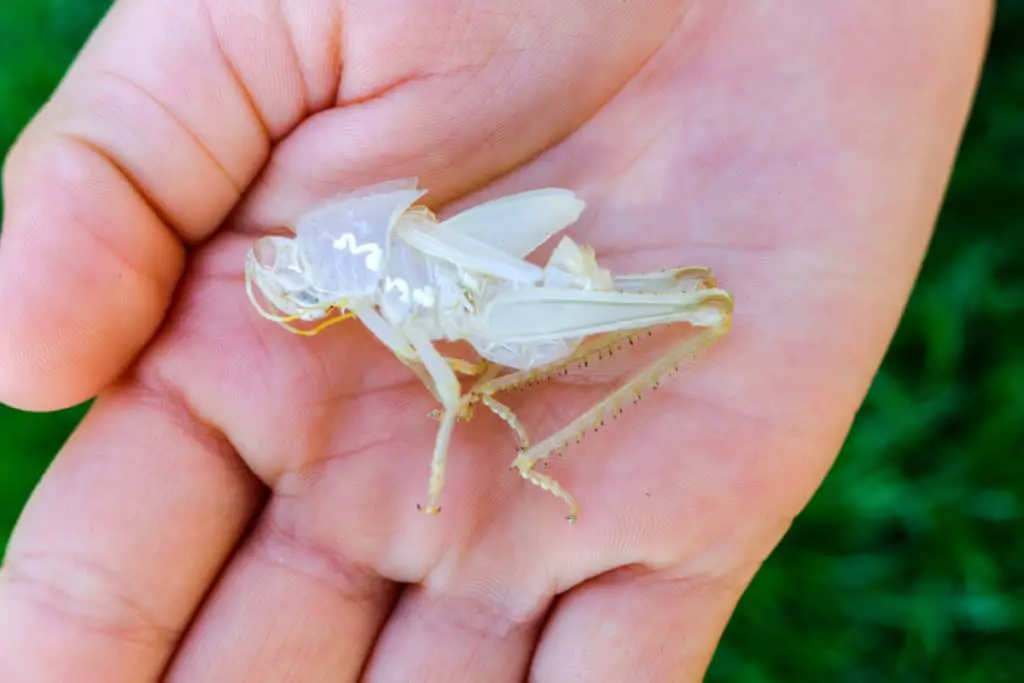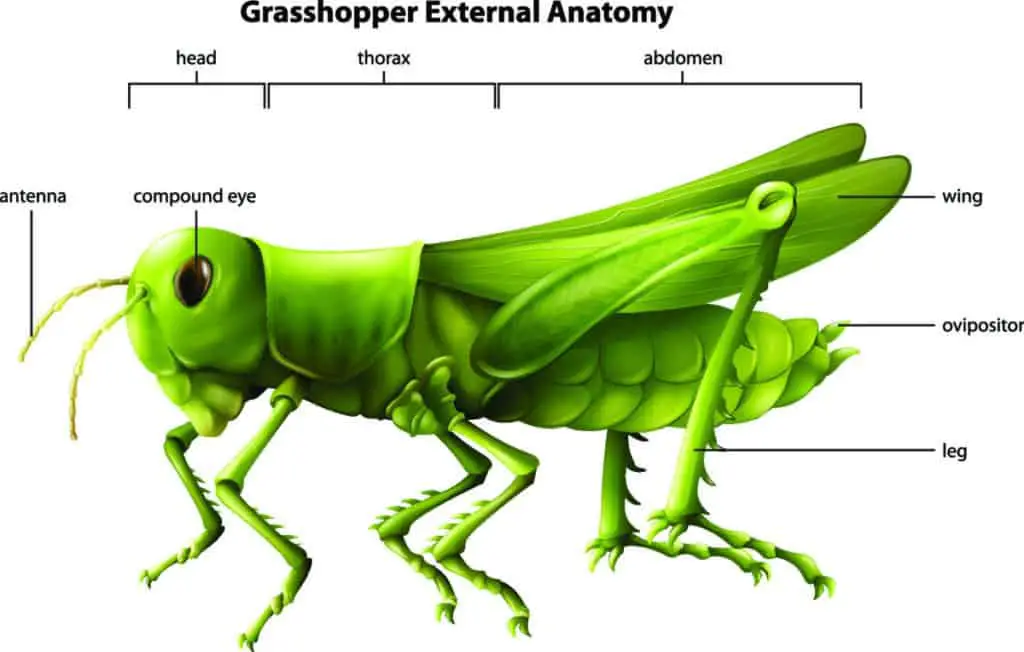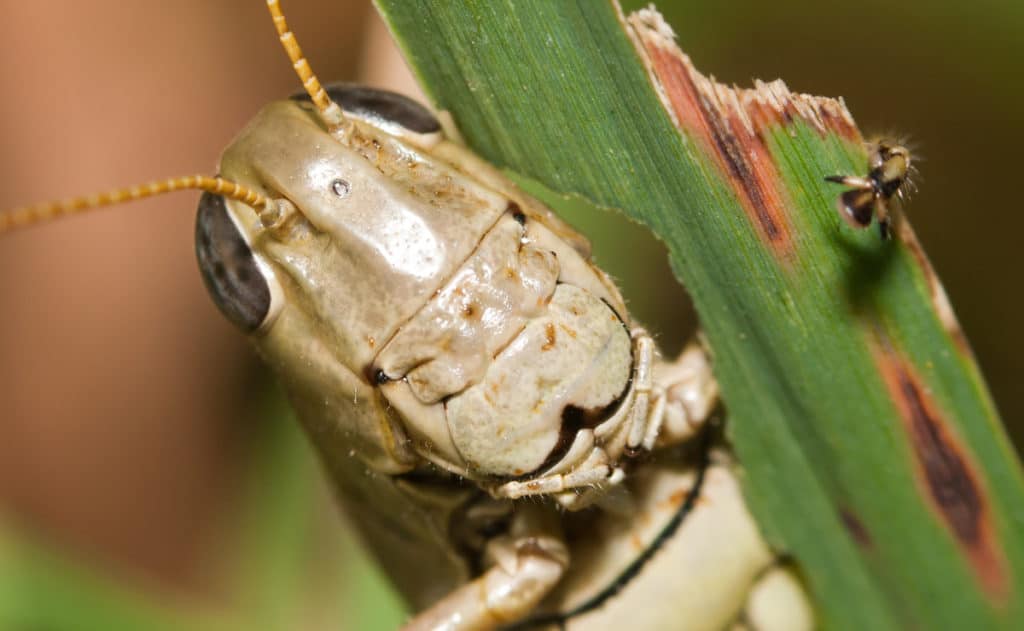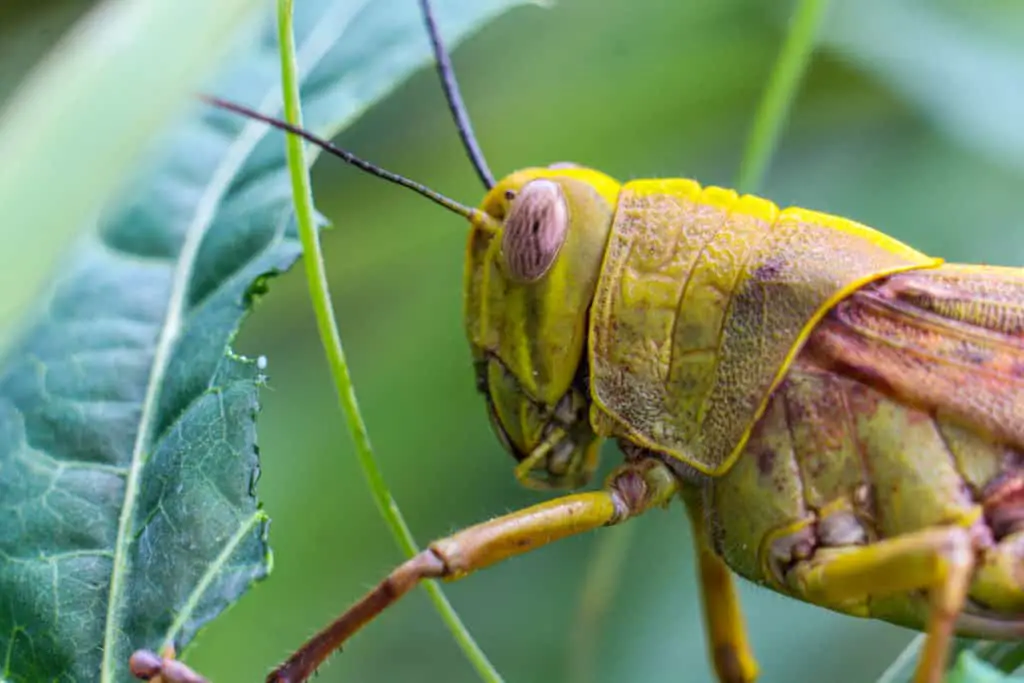Have you ever seen how a grasshopper jumps around the garden, smashing into walls, trees, and sometimes even you, and wondered why they don’t get hurt?
Grasshoppers are invertebrates, so they have no backbone. Grasshoppers have an exoskeleton, a solid chitinous shell on the outside of their bodies. The exoskeleton is hard armor plating that covers and protects their body. The exoskeleton is molted 5 to 6 times as the grasshopper becomes an adult.
Stay with us as we take a deeper look at how the grasshoppers’ exoskeleton works and why they don’t need backbones or any bones as we know them.
What Is The Skeletal Structure Of A Grasshopper?
Grasshoppers have a body that is made in three parts which are covered with a hard shell form of exoskeleton made from chitin.

The body of a grasshopper consists of three parts:
- The Head
- The Thorax
- The Abdomen
Check out the image below showing the location of each of these body parts. Then stay with us as we will explain the role of each of these parts. We also have some great close-up images to show you.

The exoskeleton is separated into sections with flexible joints that allow movement more easily, something like human body armor.
1. The Head
The head of the grasshopper consists of a brain, antennae, eyes, and mouthparts. The mouthparts include the crushing and masticating jaws known as mandibles.
We do have an entire article on grasshoppers and what they can and can’t bite into. If you are interested check this article out, Do Grasshoppers Bite?

The antennae on a grasshopper are normally short, but there are some species of grasshopper that have much larger antennae.
Grasshoppers have three straightforward eyes called ocelli. There is one eye above the base of each antenna and one centrally located in the frontal costa.
Just behind the head is the plate-like formation known as the “pronotum,” which is intended to protect a grasshopper’s thorax.

2. The Thorax
The wings and the legs of a grasshopper are situated in the midsection otherwise known as the thorax. The front wings are lean and hard and are named the “tegmina”.
Their back wings are broad and supple. The back wings provide more flying strength than the front wings.
If you are interested we have written an article all about the grasshopper’s ability to fly. The article is called, Can Grasshoppers Fly?
Grasshoppers have three pairs of legs. The front two pairs are smaller than the last pair (hind legs).
The two front pairs of legs are used primarily for walking and for holding food, While the hind legs are specifically used for jumping and hopping.
Each leg has a foot and that is named the “tarsi”.
3. The Abdomen
The abdomen is merged to the last section of the thorax, also known as the “metathorax“.
The back end of the grasshopper is named the abdomen.
Here the grasshopper has its breathing holes, hearing organs which are known as “tympanum”, reproductive and digestive systems plus its heart.
In other words, the abdomen is the grasshopper’s powerhouse.
Do Grasshoppers Have Any Other Types Of Bones?
Although it may seem like there needs to be at least some internal bones for a grasshopper to function, particularly in their legs for jumping, the answer is no.
Grasshoppers do not have any type of bone as their bodies consist of only an exoskeleton.
Grasshoppers Are Cold Blooded
Grasshoppers are cold-blooded similarly to all other insects and therefore need warm temperatures to feed and reproduce.
Even though grasshoppers have a body temperature that adapts to their environmental temperature, the actual body temperature is important,
The internal temperature of a grasshopper can affect movement, digestion, food consumption, water retention, egg, and nymph survival rate, as well as their life expectancy.
Grasshoppers normally turn their back upright to the sun’s rays. Crouching provides heat absorption from a temperate surface into the abdomen, while extending their legs is used to cool them down.
Does A Grasshopper’s Structure Change Between Subspecies?
Grasshoppers fit into the suborder Caelifera. Grasshopper is also used as a common name for the infraorder (taxonomic category below a suborder) Acrididea and has been referred to as “short-horned grasshoppers”
Then you have to distinguish them from the term “long-horned grasshoppers”, which also consists of bush crickets or katydid.
Long-horned grasshoppers, as the name suggests, have much longer antennae.
There are about 11,000 different known species of grasshopper. The different species have different sizes which range from 1/2 inch to as big as seven centimeters.
In several species, the wings are brilliantly colored although most of the grasshoppers’ coloring is green, brown, or gray.
This natural ghillie suit enables them to merge into their surroundings.
Grasshoppers also have large mouthparts for chewing and crushing food which differ in size according to the species.
On a side note, we are often asked if grasshoppers will eat ants? So much so that we have written an article on the topic, Do Grasshoppers Eat Ants? Or is it the other way around?
The Long-horned grasshoppers’ identifying trait is their antennae, which is longer than their wings, while short-horned grasshoppers have short, stumpy antennae.
If you live in Flordia and you are wondering what grasshopper species you will find there the check out this article we have written, Grasshoppers In Florida: Your Complete Guide.
What Are The Benefits Of Grasshoppers Not Having A Backbone?
The exoskeleton provides the ability to transform. This is particularly the case with insects that do not go through complete transformation such as grasshoppers.
Exoskeletons are made up of chitin. The calcium carbonate within chitin makes them hard and strong.
Ingrowths of the arthropod exoskeleton known as apodemes provide additional places for muscles.
These configurations are packed with chitin and are about six times stronger and twice the stiffness of vertebrate tendons.
Apodemes can draw out to store elastic energy for jumping, especially in grasshoppers.
Where Does the Word “Exoskeleton” Come From?
The word exoskeleton is derived from the Greek words Exo, meaning “outer” and skeletos meaning “skeleton”.
This is the external skeleton that supports and protects the grasshopper’s body like a suit of armor.
This is different from the internal skeleton (endoskeleton) of mammals, reptiles, and birds.
An exoskeleton sometimes called an exosuit, is a rigid or articulated cover that supports and protects the soft tissues of grasshoppers.
The exoskeleton prevents dehydration in arthropods.
The flexible joints allow the grasshopper a large range of freedom when it comes to movement.
The exoskeleton does not grow but must be molted on a regular basis and a new one generated.
The Exoskeleton Protects Grasshoppers From Predators
Grasshoppers have a number of predators. They are preyed upon by animals and other arthropod predators.
The exoskeleton allows the mechanisms of leaping and jumping with strong hind legs.
Having an exoskeleton gives grasshoppers the ability of autotomy.
This is a process in grasshoppers whereby one or both of their hind limbs can be discarded to escape a predator or can be abandoned if damaged.
This is the same as some lizards do when they drop their tail to distract their predators.
This happens between the trochanter and the second and third leg segments, but once lost, unlike lizards, the legs never regenerate.
Autotomy cuts branches of the leg nerve but no damage is done to muscles as none span the autotomy plane.
However, grasshoppers cannot regrow limbs once they are fully mature, as they stop replacing their exoskeleton once they reach maturity.
To find out more about the full lifecycle of the grasshoppers have a look at this article we have written, The Lifecycle Of Grasshoppers
The Exoskeleton Protects Grasshoppers From The Climate
Because grasshoppers are cold-blooded, they normally produce very little body heat and rely on heat that is generated from their environment.
The exoskeleton makes a physical barrier between the inside and outside of the body and regulates water retention.
The primary heating source for life on our planet comes from the sun.
The insect’s exoskeleton forms the barrier between these electromagnetic waves and the internal body parts which, in turn, regulates internal body temperature.
This being said, studies surrounding climate change have found that in recent years there seem to be definite changes in the lifespan of different species within the communities of grasshoppers residing in various altitudes.
The Exoskelton Enables A Vigorous Jumping Lifestyle
The grasshopper’s hind legs are built to withstand huge bending forces when it jumps. They operate like small catapults.
When the grasshopper is about to jump, it contracts the huge flexor muscles slowly, bending its hind legs at the knee joint.
A particular piece of cuticle within the knee behaves like a spring, amassing up all the latent energy.
The grasshopper then loosens up its leg muscles, permitting the spring to discharge its energy and hurl the insect into the air.
One of the most formidable predators for grasshoppers is the praying mantis. If you are interested we have written an article that takes a side-by-side look at these two insects. Check it out, Grasshopper Vs Praying Mantis
What Are The Disadvantages Of Having An Exoskeleton?
The disadvantages of having an exoskeleton are that it cannot widen or enlarge. This creates a major restriction on growth.
The exoskeleton has to be shed on regular occasions, and whilst the molting is happening which is an essential part of the growth, the grasshopper is left vulnerable to predators.
Approximately 85 percent of grasshopper deaths happen during molting. The insect is extremely vulnerable during and directly after this time.
Many deaths also occur due to malfunctions of the molting itself. The process requires careful timing and chemical balances.
Sometimes mutilations and loss of limbs happen which makes this an even more dangerous time for a grasshopper.
The Wrap Up
Grasshoppers, although extremely agile, do not have a backbone.
In fact, there are no bones present in the anatomy of a grasshopper, except for the exoskeleton, which could be considered one large outside bone for the purpose of understanding.
Although they do not have any bones, the exoskeleton, the grasshopper’s body armor gives them literally a solid line of defense in a world where everything is out to get them.
Sources
https://www.ncbi.nlm.nih.gov/pmc/articles/PMC2944887/
https://en.wikipedia.org/wiki/Autotomy
https://science.jrank.org/pages/3122/Grasshoppers-Defense.html#ixzz6ccSerfOA
https://www.sciencedirect.com/topics/medicine-and-dentistry/exoskeleton
https://science.jrank.org/pages/3121/Grasshoppers-Body-temperature.html
